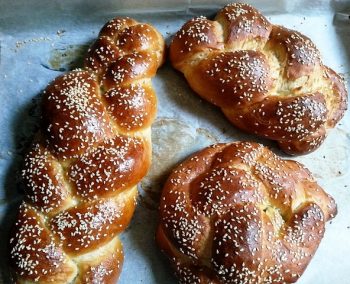Eating Kosher Posted by Ayana on Oct 22, 2018 in Uncategorized
Kosher (כָּשֵׁר, pronounced as ka-sher) is a Hebrew adjective, meaning “fit”, “proper”, or “correct”. כָּשֵׁר also means “fit to eat” according to the Jewish laws of Kashruth (כַּשְׁרוּת) – a set of dietary rules that dictates what kinds of food can be eaten and how it needs to be prepared.
The כַּשְׁרוּת laws concerns any kind of food. Milk and eggs are included, and apparently not all kinds of milk and eggs are permitted for eating (מֻתָּר לַאֲכִילָה). It depends on the animal. The rule, as it quoted in the Babylonian Talmud – a Jewish text from the 5th century CE – says:
הַיּוֹצֵא מׅן הַטָּמֵא – טָמֵא, וְהַיּוֹצֵא מׅן הַטָּהוֹר – טָהוֹר.
Literally means: “what comes out of the impure is impure, and what comes out of the pure is pure”. If the animal is “pure”, that is to say permitted for eating, so will be its products. The cow, for example, is a kosher animal, and therefore cow milk is kosher as well. Chicken is also a kosher animal, hence its eggs are permitted for eating. Sheep and goat are kosher, so their milk is מֻתָּר לַאֲכִילָה, too. Quail is a kosher bird and so its eggs. But how we decide which animal is טָמֵא (impure), and which animal is טָהוֹר (pure)? The bible enjoins:
“זֹאת הַחַיָּה אֲשֶׁר תֹּאכְלוּ מִכָּל הַבְּהֵמָה אֲשֶׁר עַל הָאָרֶץ; כֹּל מַפְרֶסֶת פַּרְסָה, וְשֹׁוסַעַת שֶׁסַע פְּרָסֹות, מַעֲלַת גֵּרָה, בַּבְּהֵמָה אֹותָהּ תֹּאכֵלוּ.”
“These are the animals which you may eat among all the animals that are on the earth; Among the animals, whatever divides the hoof, having cloven hooves and chewing the cud — that you may eat.” (book of Leviticus, chapter 11, verses 2–3)
The bible gives three conditions – the land animal must have hooves (מַפְרֶסֶת פַּרְסָה), the hooves must be split (שֹׁוסַעַת שֶׁסַע), and the animal must be ruminant (מַעֲלַת גֵּרָה). Chapter 11 in the book of Leviticus gives examples of animals who don’t meet the criteria. The camel is the first example mentioned as an animal that chew its cud but doesn’t has hooves. So are the coney and hare. The pig, on the other hand, has hooves and they are even cloven, but he is not a ruminant animal, and hence is not כָּשֵׁר (kosher).
The bible elaborates on the conditions of kosher sea animals:
“אֶת זֶה תֹּאכְלוּ מִכֹּל אֲשֶׁר בַּמָּיִם: כֹּל אֲשֶׁר לוֹ סְנַפִּיר וְקַשְׂקֶשֶׂת בַּמַּיִם, בַּיַּמִּים וּבַנְּחָלִים אֹותָם תֹּאכֵלוּ. וְכֹל אֲשֶׁר אֵין לוֹ סְנַפִּיר וְקַשְׂקֶשֶׂת בַּיַּמִּים וּבַנְּחָלִים, מִכֹּל שֶׁרֶץ הַמַּיִם וּמִכֹּל נֶפֶשׁ הַחַיָּה אֲשֶׁר בַּמָּיִם שֶׁקֶץ הֵם לָכֶם.“
“Of all the creatures living in the water of the seas and the streams, you may eat any that have fins and scales. But all creatures in the seas or streams that do not have fins and scales whether among all the swarming things or among all the other living creatures in the water you are to detest.” (book of Leviticus, chapter 11, verses 9–10)
For sea animals to be כָּשֵׁר there are two conditions: only fish with fins (סְנַפִּיר) and scales (קַשְׂקֶשֶׂת) may be eaten. Tuna, salmon, carp, sea-bass, sardine and herring, for instance. Shellfish such as shrimps, crabs, mussels, and lobsters are forbidden to eat.
The bible doesn’t give us signs for birds, so there are no conditions for us to determine which are טָמֵא (impure) and which are טָהוֹר (pure). It simply details twenty non-kosher poultries:
“וְאֶת אֵלֶּה תְּשַׁקְּצוּ מִן הָעוֹף, לֹא יֵאָכְלוּ שֶׁקֶץ הֵם: אֶת הַנֶּשֶׁר, וְאֶת הַפֶּרֶס, וְאֵת הָעָזְנִיָּה. וְאֶת הַדָּאָה וְאֶת הָאַיָּה לְמִינָהּ. אֵת כָּל עֹורֵב לְמִינוֹ. וְאֵת בַּת הַיַּעֲנָה וְאֶת הַתַּחְמָס וְאֶת הַשָּׁחַף וְאֶת הַנֵּץ לְמִינֵהוּ. וְאֶת הַכּוֹס וְאֶת הַשָּׁלָךְ וְאֶת הַיַּנְשׁוּף. וְאֶת הַתִּנְשֶׁמֶת וְאֶת הַקָּאָת וְאֶת הָרָחָם. וְאֵת הַחֲסִידָה, הָאֲנָפָה לְמִינָהּ; וְאֶת הַדּוּכִיפַת, וְאֶת הָעֲטַלֵּף.“
“And these you shall regard as an abomination among the birds; they shall not be eaten, they are an abomination: the eagle, the vulture, the buzzard, the kite, and the falcon after its kind; every raven after its kind, the ostrich, the short-eared owl, the sea gull, and the hawk after its kind; the little owl, the fisher owl, and the screech owl; the white owl, the jackdaw, and the carrion vulture; the stork, the heron after its kind, the hoopoe, and the bat.” (Book of Leviticus, chapter 11, verses 13–19)
Jews do not eat these twenty birds or their eggs. But even the permitted kinds of eggs have one more strict rule. The eggs of kosher birds are permitted as long as they do not contain blood. Therefore, eggs must be individually examined. If you crack open an egg to make an omelet, and notice blood inside, the egg should be thrown away.
Milk, and all its derivatives – cream, cheese, butter etc., are never to be combined with meat. “לֹא תְבַשֵּׁל גְּדִי בַּחֲלֵב אִמּוֹ” (“You shall not boil a young goat in its mother’s milk”) is a prohibition that appears three times in the bible (in the book of Exodus, chapter 23, verse 19, for instance). Jewish scholars expand this prohibition of eating, two thousand years ago. They banned cooking, eating and serving of meat products with milk on all its forms. Cheeseburger, pepperoni pizza and even chicken Parmesan are not kosher.
This rule is scrupulously upheld in kosher diners and observant Jewish households. In which, two separate sets of dish are served: one for dairy meals (חֲלָבִי), and the other for meat dishes (בְּשָׂרִי). Public diners mark their meat utensils in red, and their dairy utensils in blue. The dairy cutlery is also distinguished from the meat cutlery by a small hole in the handle. A religious family might even have two basins in their kitchen and two refrigerators.
After meat meals, one should wait six hours before eating dairy. After dairy consumption, on the other hand, drinking and eating a small piece of food is enough and no need to wait a few hours. Drinking water and eating bread, for example, will do. If you ate meat or dairy you are allowed to eat anything that is parve (פַּרְוֶה). פַּרְוֶה is a food that is not meat or dairy. A kosher meat meal will be followed by parve desserts – desserts that don’t consist dairy products.
Vegetables, fruits and grains are kosher, but must be clean from insects. All products grow in the soil or on plants are kosher, but chapter 11 in the book of Leviticus ban Jews from eating worms, flies, insects etc. Flour, for example, must be sifted shortly before use, to make sure no small insects have hatched inside it.
To summarize, here are the basics of the כַּשְׁרוּת laws:
1) Kosher animals are the ones who have cloven hooves and chew their cud.
2) Certain types of birds are not kosher.
3) Milk and eggs are kosher as long as they came out of kosher animal or bird.
4) Meat and milk should never be combined together.
5) Insects are not kosher, so vegetables, fruits and grains should be clean from insects to be kosher.
But, believe it or not, this is only the beginning of it. There numerous rules, laws and customs regarding the soil, the timing of harvest, the donations from the harvest, the wine, the animals’ conditions, the flesh parts, the process of slaughter, and so on. But as long as you know the basics you are safe.
This video is a little bit long but quite interesting. A European tourist in the southern city of Israel, Eilat, decided to check out the differences between the kosher McDonald’s and the non-kosher McDonald’s. The two stores located in the same mall, and the tourist got the help of the locals, so you can also practice your Hebrew listening comprehension on the way:
Text vocabulary
כָּשֵׁר (ka-sher) = fit, proper, or correct. Also means fit to eat according to the Jewish laws of Kashruth.
כַּשְׁרוּת (kash-rut) = Kashruth , a set of dietary Jewish rules that dictates what kinds of food can be eaten.
מֻתָּר (mu-tar) = permitted, allowed
אֲכִילָה (a-chi-la) = eating
מֻתָּר לַאֲכִילָה = permitted for eating
טָמֵא (ta-me) = impure
טָהוֹר (ta-or) = pure
חַיָּה (ha-ya) = animal
עוֹף (of) = bird, poultry
חָלָב (ha-lav) = milk
חֲלָבִי (ha-la-vi) = diary
בָּשָׂר (ba-sar) = meat
בְּשָׂרִי (be-sa-ri) = related to meat
פַּרְוֶה (par-ve) = not meat or dairy
Keep Calm and Eat Kosher

Build vocabulary, practice pronunciation, and more with Transparent Language Online. Available anytime, anywhere, on any device.







